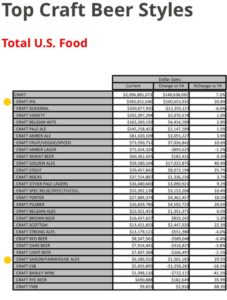 This graph… err… table to the left right was posted on the internets today by Jeff Alworth. It is tied by him to the piece in GBH by Bryan Roth about the meaning of IPA – which has the wonderful and likely most accurate thing about IPA or even craft I have read: “IPAs are what people want from me, you kind of have to give them what they want…” Jeff posted a piece himself on the now stone cold demise of of “craft” – an event I sent my funeral wreath and condolences in relation to over two and half years ago. Oliver Grey wanted it put out of its misery even further back.
This graph… err… table to the left right was posted on the internets today by Jeff Alworth. It is tied by him to the piece in GBH by Bryan Roth about the meaning of IPA – which has the wonderful and likely most accurate thing about IPA or even craft I have read: “IPAs are what people want from me, you kind of have to give them what they want…” Jeff posted a piece himself on the now stone cold demise of of “craft” – an event I sent my funeral wreath and condolences in relation to over two and half years ago. Oliver Grey wanted it put out of its misery even further back.
The main point to focus on today, however, is not the disutility of the terms but the disutilty of the graph. It goes to a notion of abstraction and levels of abstraction. The graph offers a fabulous illustration of the failure to align levels of abstraction. You will see, yippee, that IPA wins in the race to top the craft beer style race. The problem is not whether this is correct or not as we all know people who know nothing about craft beer who ask for an IPA. It’s the chardonnay of white wine circa 1999 in that respect. Code for (i) something that the drinker will like (ii) that the bartender will understand (iii) because the bar likely stocks it. Because “…you kind of have to give them what they want…”
The problem is that IPA is an umbrella term, even if a useful one. Consider the other terms in the list. “Craft Scottish,” “craft porter,” “craft dark beer” and even “craft amber” might for the average person reasonably all fit into “craft brown beer” as an umbrella term. “Craft IPA” on the other hand is known to include unspecified styles like IPA itself, DIPA, TIPA, BIPA, WIPA and any number of other Franken-styles designed primarily to ram the three letters “I” and “P” and “A” onto the label to ensure that the code speaking person in the bar orders one thus making the sale. Does this mean IPAs are not the most popular category? No. Does it mean I always know what I will get in the glass when I order one? The answer, compared to say pilsner, is also no.
As the ripples on the lake into which “craft” was flung a few years ago spread out to their limit and fade, we should be aware of how its fate was tied to it becoming an abstract concept prone to influence, interest and malleability. For me, IPA is half way down that same slippery slope.* I look for other words to guide me beyond the relative hop intensity flag that it waves. As has happened over and over, hop intensity itself fades as either or both an offering or a preference. You see it starting in the fruity murk that I have been, frankly, fooled a few times into ordering. As in the past, what is an IPA might be now or in the future be quite forgotten for the very reason that graph unintentionally demonstrates.
*…because, see, before badly used words are flung into the lake they slide down a slippery slope. Presumably there is a ramp involved near shoreline.

I actually would think that a table is a form of graph if a graph is a graphical presentation of data. But that is me. Others may see see the distinction.
If we’re talking about how soon we declared the end of craft, I should mention my first obituary came five years ago: https://www.beervanablog.com/beervana/2011/09/entering-post-craft-world.html Yesterday’s post was more a an exhumation for theatrical purposes.
Five years ago. Maybe it never was!
When was Rogue’s bacon doughtnut ale first trotted out? That has to have been at least the first trip to the ER.
“Added by msubulldog25 on 09-01-2011”
I’d accept that as the time of death.
Excellent!
I would pick ‘chablis’ —the restaurant synedoche of the 1970s, 1980s, and early 1990s for ‘white wine’— to be more apt, than ‘chardonnay,’ as a metaphor for the ‘eepuh’ of the 2010s.
Yes, that works even better.
BTW – I love actual Chablis Grand Cru. Like Riesling a great way to get an understanding of minerality.
I put it at the day the brewers association tortured ‘traditional’ into meaning ‘traditional and innovative.’ That’s like ‘new and improved’. It is not as though it was anything other than a marketing concept, but as soon as you violate your own internal logic there ceases to be cohesion. That came at about the same time they let in the 19th century lager brewers for a one time statistical growth bump. They knew this was coming otherwise they wouldn’t have aimed for that bump.